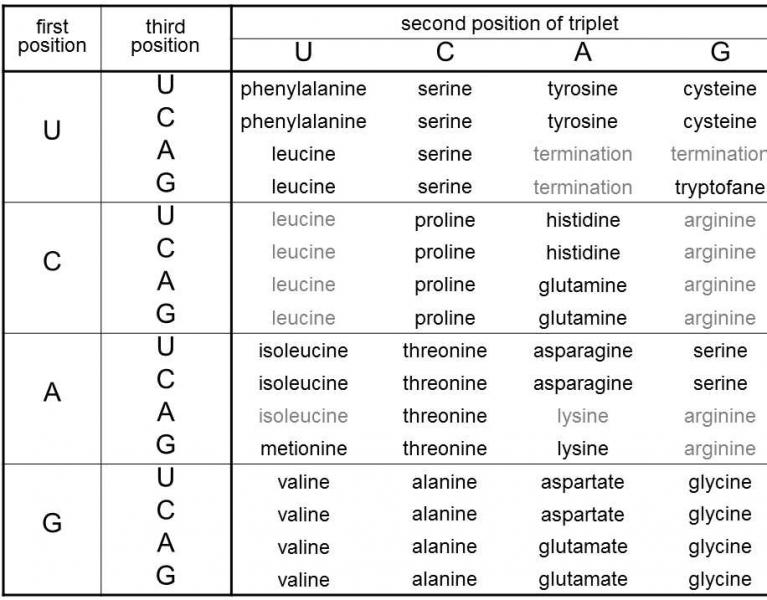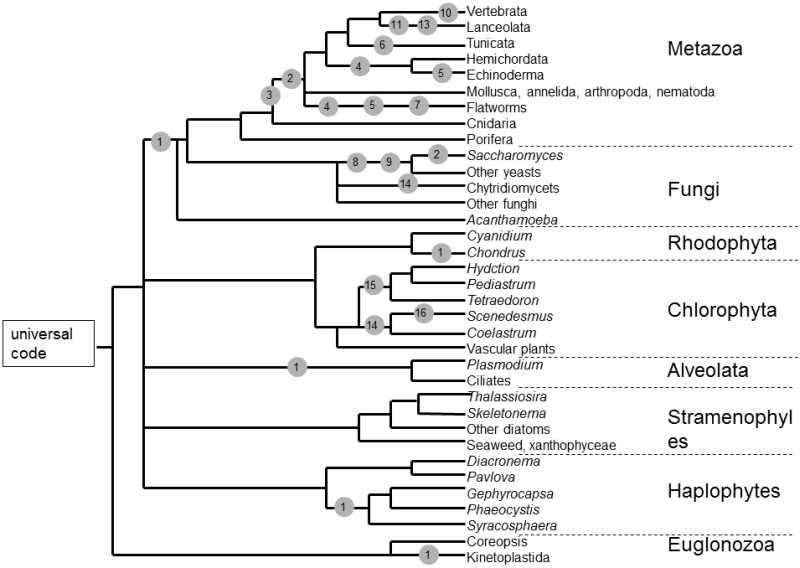X.3.3.3.4 The existence of modified variants of the genetic code in some organisms is direct evidence for its capability for evolution
The fact that the genetic code is capable of at least a limited degree of evolution is reflected by the existence of modified genetic codes, which are encountered in the nuclei in some groups of protozoa and also quite frequently in organelles of symbiotic origin – in mitochondria (Fig. X.8).Simultaneously, the positions of the individual groups of organisms with modified genetic code within the phytogenetic tree indicate that their predecessors had a classical universal genetic code (Cedergren & Miramontes 1996).The same changes occurred repeatedly, in both related and unrelated species (Fig. X.9).The commonest deviation lies in the assignment of some aminoacids to one of the terminal codons.Codons UAA and UAG began to encode glutamine in some ciliates, Acetabularia single-celled algae and Hexamita flagellatae; the UGG codon began to encode tryptophane in many ciliates, in mycoplasma and, for example, also in the mitochondria of vertebrates.The most frequently mentioned mechanism of allocation of a certain triplet to a nonstandard aminoacid is temporary disappearance of the particular triplet from the genome (its function continues to be borne by the other synonymous triplets), disappearance of the original tRNA, reappearance of the given triplets at different places on the DNA and the connected selection in favour of formation of tRNA that is capable of reading the given codon (at least in some way).This mechanism is apparently possible primarily in mitochondrial DNA and perhaps in mycoplasma – i.e. in systems where the genome is relatively small and where the first stage of the above-described 4-stage process can relatively easily occur (Jukes 1981; Jukes & Osawa 1993).On the other hand, in ciliates, a different mechanism tends to be assumed – in principle based on the existence of micronuclei and macronuclei in their cell and the existence of “macronuclear heredity” (Cohen & Adoutte 1995).

Fig. X.8. Modified genetic codes. In the table of the universal genetic code, the grey colour denotes positions that, in the genetic codes of organelles or also in the nuclei of some taxons, differ most frequently in their meaning from the universal genetic code. According to Knight et al. (1999).

Fig. X.9. Changes in the mitochondrial genetic code during the phylogenesis of eukaryotes. While respecting the principle of maximum parsimony, the individual changes in the mitochondrial genetic code were located on the phylogenetic tree of the eukaryote formed on the basis of the sequence of genes for rRNA. It is apparent from the locations of the individual evolutionary events that some changes must have occurred repeatedly. Meaning of the individual evolutionary events: 1 –UGA stop → Trp, 2 – AUA Ile → Met, 3 – AGA, AGG Arg → Ser, 4 – AUA Met → Ile, 5 – AAA Lys → Asn, 6 – AGA, AGG Ser → Gly, 7 – UAA stop → Tyr, 8 – CUN (kde N = U, C, A, G) Leu → Thr, 9 – CGN Arg → ?, 10 – AGA, AGG ? → stop, 11 – AGA ? → Gly, 12 – AGA, AGG Ser → ?, 13 – AGA ? → Ser, 14 – UAG stop → Leu, 15 – UAG stop → Ala, 16 – UCA Ser → stop. The rooting of the phylogenetic tree must be seen as only provisional; according to some authors, the root of the phylogenetic tree of eukaryotes is located in a different place and the overall topology can still undergo substantial changes. Modified according to Knight et al. (2001).
It is interesting that the development of nonstandard genetic codes is accompanied by a certain degree of optimization of the original universal genetic code.For the universal genetic code, 3% of transitions in the third position in the triplet lead to substitution mutations, while, for the mitochondrial genetic code of vertebrates, no transition in the third position of the triplet leads to a substitution mutation (Wakeley 1996).According to different criteria (minimization of the impact of errors occurring during translation), however, the mitochondrial code appears to be suboptimal compared to the universal code (Knight, Freeland, & Landweber 2001).
It is possible that the original genetic code evolved on the basis of direct stereochemical interactions between the nucleotides and aminoacids and later became more complicated as a consequence of biochemical modifications of the individual aminoacids and assignment of the thus-formed new aminoacids to the originally synonymous codons and finally (or in parallel) this was optimized from the standpoint of preference for mutation conservativeness and translation errors through similar mechanisms as were valid during the formation of modified genetic codes (Knight, Freeland, & Landweber 1999).
